Corliss steam engine
A Corliss steam engine (or Corliss engine) is a steam engine, fitted with rotary valves and with variable valve timing patented in 1849, invented by and named after the US engineer George Henry Corliss of Providence, Rhode Island.
.jpg.webp)
Engines fitted with Corliss valve gear offered the best thermal efficiency of any type of stationary steam engine until the refinement of the uniflow steam engine and steam turbine in the 20th century. Corliss engines were generally about 30 percent more fuel efficient than conventional steam engines with fixed cutoff.[1] This increased efficiency made steam power more economical than water power, allowing industrial development away from millponds.[2]
Corliss engines were typically used as stationary engines to provide mechanical power to line shafting in factories and mills and to drive dynamos to generate electricity. Many were quite large, standing many metres tall and developing several hundred horsepower, albeit at low speed, turning massive flywheels weighing several tons at about 100 revolutions per minute. Some of these engines have unusual roles as mechanical legacy systems and because of their relatively high efficiency and low maintenance requirements, some remain in service into the early 21st century. See, for example, the engines at the Hook Norton Brewery and the Distillerie Dillon in the list of operational engines.
Corliss engine mechanisms
Corliss engines have four valves for each cylinder, with steam and exhaust valves located at each end. Corliss engines incorporate distinct refinements in both the valves themselves and in the valve gear, that is, the system of linkages that operate the valves.
The use of separate valves for steam admission and exhaust means that neither the valves nor the steam passages between cylinders and valves need to change temperature during the power and exhaust cycle, and it means that the timing of the admission and exhaust valves can be independently controlled. In contrast, conventional steam engines have a slide valve or piston valve that alternately feeds and exhausts through passages to each end of the cylinder. These passages are exposed to wide temperature swings during engine operation, and there are high temperature gradients within the valve mechanism.
Clark (1891) commented that the Corliss gear "is essentially a combination of elements previously known and used separately, affecting the cylinder and the valve-gear".[3] The origins of the Corliss gear with regard to previous steam valve gear was traced by Inglis (1868).[4]
Corliss valve gear
.jpg.webp)
George Corliss received U.S. Patent 6,162 for his valve gear on March 10, 1849. This patent covered the use of a wrist-plate to convey the valve motion from a single eccentric to the four valves of the engine, and it covered the use of trip valves with variable cutoff under governor control that characterize Corliss Engines.[5] Unlike later engines, most of which were horizontal, this patent describes a vertical cylinder beam engine, and it used individual slide valves for admission and exhaust at each end of the cylinder.
The inlet valves are pulled open with an eccentric-driven pawl; when the pawl trips, the rapid closure is damped using a dashpot. In many engines, the same dashpot acts as a vacuum spring to pull the valves closed, but Corliss's early engines were slow enough that it was the weight of the dashpot piston and rod that closed the valve.
The speed of a Corliss engine is controlled by varying the cutoff of steam during each power stroke, while leaving the throttle wide open at all times. To accomplish this, the centrifugal governor is linked to a pair of cams, one for each admission valve. These cams determine the point during the piston stroke that the pawl will release, allowing that valve to close.
As with all steam engines where the cutoff can be regulated, the virtue of doing so lies in the fact that most of the power stroke is powered by the expansion of steam in the cylinder after the admission valve has closed. This comes far closer to the ideal Carnot cycle than is possible with an engine where the admission valve is open for the length of the power stroke and speed is regulated by a throttle valve.
The Corliss valve gearing allowed more uniform speed and better response to load changes, making it suitable for applications like rolling mills and spinning, and greatly expanding its use in manufacturing.[6][7]
Corliss valves
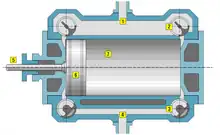
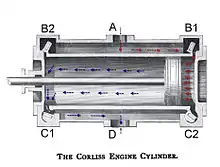
Corliss valves open directly into the cylinder. The valves connect the cylinder to separate steam and exhaust plenums. Initially, Corliss used slide valves with linear actuators, but by 1851, Corliss had shifted to semi-rotary valve actuators, as documented in U.S. Patent 8253.[8] In this engine, the wrist plate was moved to the center of the cylinder side, as on later Corliss engines. This was still a beam engine, however, and the semi-rotary valve actuators operated linear slide valves inside the four valve chests of the engine.
Corliss valves are in the form of a minor circular segment, rotating inside a cylindrical valve-face. Their actuating mechanism is off along the axis of the valve, thus they have little "dead space" such as the stem of a poppet valve and the entire port area can be used efficiently for gas flow.
As the area of a Corliss valve is small compared to the port area, the effects of gas flow generate relatively little torque on the valve axle compared to some other sorts of valve. These advantages have led to the Corliss form of valve being used in other roles, apart from steam engines with Corliss gear.
The Rolls-Royce Merlin aero-engine used a rectangular butterfly valve as a throttle. Gas-flow forces acting asymmetrically on this butterfly could lead to poor control of the power in some circumstances. Late models, from the 134, used a Corliss throttle valve instead to avoid this problem.[9]
Barring and barring engines
A common feature of large Corliss engines is one or two sets of narrow gear teeth in the rim of the flywheel.[10] These teeth allow the flywheel to be barred, that is, turned with the aid of a crowbar.[11] This may be needed during engine maintenance, for example, to set the cutoff and admission valve timing, and it may be needed during engine starting.
The need for barring the engine during starting is most obvious on single-cylinder engines, where a careless engine operator might stop the engine with the piston in or near dead center. Once stopped in this state, the engine cannot be started under its own power, so it must be barred to a more favorable position for starting.
Large Corliss engines cannot be safely started cold, so it is common to admit low-pressure steam to both sides of the cylinder to warm up the metalwork. Turning the engine slowly during this process ensures that the entire engine is uniformly warmed, and it ensures that oil is uniformly distributed through the mechanism before applying power.[12] Again, barring may be used to do this, although operators sometimes do this by careful manual manipulation of the valves.[13]
For large engines, muscle powered barring is sufficiently difficult that barring engines are frequently installed.[14] These are small engines with gear teeth cut to mate with the teeth on the flywheel. Generally, the drive gears of the barring engine are designed to automatically disengage if the engine begins running under its own power while the barring gears are engaged.
Company history
The Corliss Steam Engine Company was originally known as Fairbanks, Clark & Co. in the 1830s. In 1843 it was renamed Fairbanks, Bancroft & Co. when Edward Bancroft joined the company. In 1846 it was renamed Bancroft, Nightingale & Co. when George H. Corliss joined the company, and in 1847 it was renamed Corliss, Nightingale and Co. In 1848 the company moved to the Charles Street Railroad Crossing in Providence, Rhode Island.
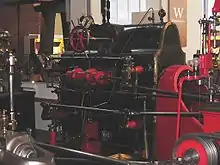
In 1857 the company was renamed for the last time to Corliss Steam Engine Company. By 1864 Corliss bought out his partners and was the sole owner of the company. In 1900 the Corliss Steam Engine Company was purchased by the International Power Company. In 1905 it was purchased by the American and British Manufacturing Company. In 1925 the company merged into Franklin Machine Company. By then Franklin Machine Company was already owned by the William A. Harris Steam Engine Company.
By 1859, all of the key features of what we now know as the Corliss engine were in place. Patents granted to Corliss and others incorporated rotary valves and crank shafts in-line with the cylinders. See, for example, Corliss' U.S. Patent 24,618, granted July 5, 1859.[15] Competing inventors worked hard to invent alternatives to Corliss' mechanisms; they generally avoided Corlis's use of a wrist plate and adopted alternative releasing mechanisms for the steam valves, as in Jamieson's U.S. Patent 19,640, granted March 16, 1858.[16]
Corliss' 1849 patent expired in 1870; the term of this patent had been extended by U.S. Patent reissue 200 on May 13, 1851, and U.S. Patent reissues 758 and 763 on July 12, 1859. B. Hick and Son were first to introduce the Corliss engine into the United Kingdom about 1864. After 1870, numerous other companies began to manufacture Corliss engines. Among them, the William A. Harris Steam Engine Company,[17] the Worthington Pump and Machinery Company,[18] and Allis-Chalmers.[19] In general, these machines were referred to as Corliss engines regardless of who made them.
Centennial Engine
The Corliss Centennial Engine was an all-inclusive, specially built rotative beam engine that powered virtually all of the exhibits at the United State Centennial Exhibition in Philadelphia in 1876 through shafts totaling over a mile in length. Switched on by President Ulysses S. Grant and Emperor Pedro II of Brazil, the engine was in public view for the duration of the fair.
The engine was configured as two cylinders side by side. Each cylinder was bored to 44 inches (112 cm) with a stroke of 10 feet (3.0 m). The Centennial Engine was 45 feet (14 m) tall, had a flywheel 30 feet (9.1 m) in diameter, and produced 1,400 horsepower (1,000 kW). After the fair it was disassembled and shipped back to Corliss's plant in Providence. Seven years later it was sold and powered a Chicago factory owned by George Pullman until 1910,[20] when it was sold as scrap.[21]
This engine became a cultural icon, so much so that to many modern historians the term Corliss Engine (or Corliss Steam Engine) refers to this specific engine and not to the broad class of engines fitted with Corliss valve gear.[22]
.jpg.webp) The Centennial Engine at the U.S. Centennial Exhibition in Philadelphia, 1876
The Centennial Engine at the U.S. Centennial Exhibition in Philadelphia, 1876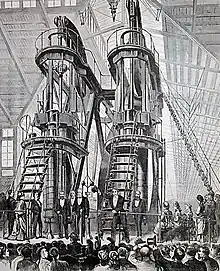 U.S. President Ulysses S. Grant and Emperor Pedro II of Brazil starting the Corliss Centennial Engine at the opening ceremonies of the Centennial Exhibition
U.S. President Ulysses S. Grant and Emperor Pedro II of Brazil starting the Corliss Centennial Engine at the opening ceremonies of the Centennial Exhibition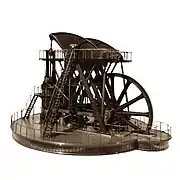 Model on display at the MIT Museum
Model on display at the MIT Museum
List of operational engines
| Location | Date of manufacture | Date of installation | Horsepower | RPM | Citation |
|---|---|---|---|---|---|
| Albert City Threshermen & Collector Show | ca. 1920 | Unknown | 125 | 120 | [23] |
| Amador Sawmill | 1904 | 2007 | 60 | 100 | [24] |
| Antique Gas and Steam Engine Museum | 1911 | 1978 | Unknown | 80 | [25] |
| Antique Gas and Steam Engine Museum | 1900 | 1986 | Unknown | Unknown | [26] |
| Arts et Metiers school of engineering of Lille | 1900 | 1900 | 75 | 60 | |
| Bancroft Shed | 1920 | 1920 | 600 | 68 | |
| Bolton Steam Museum | 1902 | 1992 | 180 | 75 | [27] |
| Bolton Steam Museum | 1914 | 1995 | 250 | Unknown | [28] |
| Bratch Pumping Station | 1894 or 1895 | 1895 or 1896 | Unknown | 24 | [29] |
| Coldharbour Mill | 1910 | Unknown | 300 | Unknown | [30] |
| Connecticut Antique Machinery Association | 1910 | 2008 | 100 | Unknown | [31] |
| Denton Farm Park | 1905 | Unknown | 350 | Unknown | [32] |
| Distillerie Dillon | 1922 | Unknown | Unknown | Unknown | [33] |
| Ellenroad Ring Mill | 1892 | Unknown | 2650 | 59 | [34] |
| Gladstone Pottery Museum | Unknown | 1925 | Unknown | Unknown | |
| Glenn Beedy Museum of Agriculture & Industry | 1923 | 1992 | 100 | 100 | [35] |
| Grand Rapids Public Museum | 1905 | Unknown | Unknown | Unknown | [36] |
| Glenwood Resource Center | 1907 | Dec 19, 1907 | Unknown | 120 | |
| Hesston Steam Museum | Unknown | Unknown | Unknown | Unknown | [37] |
| Hook Norton Brewery | Unknown | 1899 | 25 | Unknown | [38] |
| Markham Grange Steam Museum | 1909 | 1998 | 700 | 80 | [39] |
| Mill Meece Pumping Station | Unknown | Unknown | Unknown | Unknown | [40] |
| Mississippi Industrial Heritage Museum | 1905 | 2008 | Unknown | Unknown | [41] |
| Museo de la Caña de Azucar - Hacienda Piedechinche | Unknown | 1950 | Unknown | Unknown | [42] |
| National Museum of Industrial History | 1913 | 2015 | 400 | 42 | [53] |
| New England Wireless and Steam Museum | 1892 | 1978 | 150 | 80 | [43] |
| New England Wireless and Steam Museum | 1892 | 1977 | 150 | 80 | [44] |
| New England Wireless and Steam Museum | 1911 | 1969 | 150 | 80 | [45] |
| Nittany Antique Machinery Association | 150 | ||||
| Old Thresher's Reunion Heritage Museum | Unknown | Unknown | 750 | 36 | [46] |
| Old Thresher's Reunion Heritage Museum | 1920 | Unknown | 600 | 150 | [46] |
| Old Thresher's Reunion Heritage Museum | 1903 | Unknown | 125 | 110 | [46] |
| Old Thresher's Reunion Heritage Museum | Unknown | Unknown | Unknown | Unknown | [46] |
| Old Thresher's Reunion Heritage Museum | Unknown | Unknown | Unknown | Unknown | [46] |
| Owls Head Transportation Museum | ca. 1895 | Unknown | 600 | Unknown | [47] |
| Pawnee County Fairgrounds | 1912 | Unknown | Unknown | 150 | [48][49] |
| Queen Street Mill | 1895 | 1895 | 500 | 68 | |
| Saraya Sugar Factory | Unknown | 1925 | Unknown | Unknown | [50] |
| Science Museum, London: Burnley Ironworks Engine | 1903 | 1903 | 700 | 76 | |
| Stephenson County Antique Engine Club of Freeport, Illinois | 1914 | 1989 | 1500 | 45 | [51] |
| The Henry Ford | 1859 | Unknown | 500 | 70 | [52] |
| The Steam Museum | 1900 | 1986 | 100 | 90 | [53] |
| Tokomaru Steam Museum | 1916 | 1976 | 335 | 60 | [54] |
| Trencherfield Mill | 1907 | 1907 | 2500 | 68 | |
| Western Museum of Mining & Industry | 1895 | Unknown | 500 | 100 | [55] |
Notable people
See also
References
- Rosenberg; Trajtenberg (March 2004). "A General Purpose Technology at Work". The Journal of Economic History. 64 (1): 75.
- Diana Muir (2000). Reflections in Bullough's Pond. University Press of New England. p. 173.
- Clark, Daniel K. (1891). The Steam Engine. Vol. Half-vol.3. London: Blackie & Son. p. 39.
- Inglis, William (1868). "On the Corliss expansion valve-gear for stationary engines". Proceedings of the Institution of Mechanical Engineers. 19: 177–194 and plates 88 to 97. doi:10.1243/PIME_PROC_1868_019_017_02.
- US 6162A, Corliss, George H., "Cut-off and working the valves of steam engines", published 1849-03-10
- Benett, Stuart (1986). A History of Control Engineering 1800-1930. Institution of Engineering and Technology. ISBN 978-0-86341-047-5.
- Thompson, Ross (2009). Structures of Change in the Mechanical Age: Technological Invention in the United States 1790-1865. Baltimore, MD: The Johns Hopkins University Press. ISBN 978-0-8018-9141-0.
- US 8253A, Corliss, George H., "Cut-off gear", published 1851-07-29
- Harvey-Bailey, Alec; Piggott, Dave (1993). The Merlin 100 series. Rolls-Royce Heritage Trust. ISBN 1-872922-04-X.
- Norman, W. (1919). Barring diagrams. Henley Publishing. Retrieved 6 December 2011.
- The crowbar for barring the engines is visible in this photo from the Saraya Sugar Factory
- "About Us". Straffan Steam Museum. Archived from the original on 2008-09-07. See section "More about the stationary engines", subsection Single Cylinder MILL Engine, Instructions To Start Engine by Sidney J. Frazer.
- Valve manipulation is shown in this photo from the New England Wireless & Steam Museum
- Walter S. Hutton, The Practical Engineer's Handbook, Crosby, Lockwood and Son, London, 1892, pages 408 and 410
- US 24618, Corliss, George H., "Steam-engine", published 1859-07-05
- US 19640, Jamieson, Thomas S., "Improved mode of operating valves in steam-engines", published 1858-03-16
- Michael Thompson (April 18, 2016). "William A. Harris Steam Engine Co". New England Wireless & Steam Museum. Retrieved 16 October 2017.
- "Worthington Horizontal Cross-compound Pumping Engine" (PDF). Archived from the original (PDF) on 2011-08-12. Retrieved 16 October 2017.
- "A Jacksonville, Florida Historic Mechanical Engineering Landmark" (PDF). Archived from the original (PDF) on 2012-03-14. Retrieved 16 October 2017.
- Michael Thompson (January 13, 2010). "Corliss Centennial Engine". New England Wireless & Steam Museum. Retrieved 16 October 2017.
- "Some Engines!". Smithsonian Institution. Archived from the original on 2010-06-07. Retrieved 2009-11-14.
- Kasson, John F. (1999). Civilizing the Machine: Technology and Republican Values in America. Macmillan. pp. 162–167. The Corliss engine at the Centennial exhibition is discussed entirely as a cultural icon.
- Vossler, Bill (October 2017). "The Allis-Chalmers Corliss Steam Engine". Retrieved 16 October 2017.
- "History of the Amador Sawmill". Amador Sawmill. Retrieved 6 September 2012.
- "Antique Gas and Steam Engine Museum: Allis-Chalmers Corliss Engine". Antique Gas & Steam Engine Museum. Archived from the original on 19 April 2005. Retrieved 6 September 2012.
- "Antique Gas and Steam Engine Museum: Vilter Corliss Engine and Ammonia Refrigeration Compressor". Antique Gas & Steam Engine Museum. Archived from the original on 16 February 2012. Retrieved 6 September 2012.
- "Wasp Mill Tandem Compound". The Northern Mill Engine Society. Retrieved 6 September 2012.
- "Diamond Rope Works". The Northern Mill Engine Society. Retrieved 6 September 2012.
- "Bratch Pumping Station: The engines". Bratch Pumping Station. Retrieved 6 September 2012.
- "Old Engine House: other museums". Old Engine House. Archived from the original on 13 February 2012. Retrieved 6 September 2012.
- "Noble T. Greene Steam Engine". Connecticut Antique Machinery Association.
- "Bates-Corliss Engine - Picture of Denton Farm Park - Tripadvisor".
- "Residual Steam in Guadeloupe and Martinique, 2012". The International Steam Pages. Archived from the original on 28 March 2013. Retrieved 6 September 2012.
- "Victoria & Alexanda - The Worlds largest working mill steam engines". Ellenroad Engine House. Retrieved 16 October 2017.
- "Glenn Beedy Museum of Agriculture & Industry". Rock River Thresheree. Archived from the original on 1 September 2012. Retrieved 6 September 2012.
- "Artcom Museums Tour:Public Museum of Grand Rapids". Artcom Museums Tour. Retrieved 6 September 2012.
- "Hesston Steam Museum". Urban Indiana. Archived from the original on 17 August 2012. Retrieved 6 September 2012.
- "Steam at Hook Norton Brewery". Archived from the original on 7 April 2014. Retrieved 6 September 2012.
- "Agnes". Markham Grange Steam Museum. Retrieved 6 September 2012.
- "Mill Meece Pumping Station: Steam engines". Mill Meece Pumping Station. Archived from the original on 5 August 2012. Retrieved 6 September 2012.
- "This weekend: British, steam and barbecues". The Meridian Star. 5 November 2009. Retrieved 6 September 2012.
- "Museo de la Caña de Azúcar Hacienda Piedechinche". Alberto. Retrieved 27 November 2014.
- "Corliss Steam Engine, 1892". New England Wireless & Steam Museum. Retrieved 16 October 2017.
- "Harris Steam Engine, 1892". New England Wireless & Steam Museum. Retrieved 16 October 2017.
- "Harris Steam Engine, 1911". New England Wireless & Steam Museum. Retrieved 16 October 2017.
- Stuart Seedorff. "Midwest Old Thresher's Reunion:Stationary Steam". Retrieved 6 September 2012.
- "ca. 1895 Harris-Corliss". Archived from the original on 2011-11-11. Retrieved 15 January 2013.
- "National Register of Historic Places - OKLAHOMA (OK), Pawnee County". National Register of Historic Places. Retrieved 6 September 2012.
- National Register Digital Assets #79002016
- "Real Steam in India 2004 - Saraya Sugar Factory". The International Steam Pages. Retrieved 6 September 2012.
- "Cooper Corliss Engine". Stephenson County Antique Engine Club. Retrieved 6 September 2012.
- "1859 Corliss Steam Engine". The Henry Ford. Archived from the original on 13 September 2012. Retrieved 6 September 2012.
- "About Us". Straffan Steam Museum. Archived from the original on 2008-09-07. See section "More about the stationary engines", subsection Single Cylinder MILL Engine
- "The Tokomaru Steam Museum". Peter and Pauline Curtis's Information Service. Retrieved 6 September 2012.
- "Mining museum reverberates with realistic settings". The Denver Post. Retrieved 6 September 2012.
- Popular Mechanics Monthly Magazine of April 1907, commented on page 416, near the bottom right of the page, the Corliss Engine can be made to do more work by raising the boiler pressure, increasing the speed or giving less laps to the steam valves.
External links
- Chapter 14 of Audel's Engineer's and Mechanic's Guide by Frank D. Graham.
- Corliss History from the New England Wireless and Steam Museum.
- Corliss Steam Engine Basics from the Stationary Steam Preservation web pages of the Camp Creek Threshers.
- Corliss Steam Engine Co. Centennial Engine images at the New England Wireless and Steam Museum website.
- Denton Farm Park, Denton North Carolina
- SCIENTIFIC AMERICAN SUPPLEMENT NO. 286 NEW YORK, JUNE 25, 1881: 1000 hp Corliss Engine The Saltaire Engine, a Hick Hargreaves engine with illustrations.